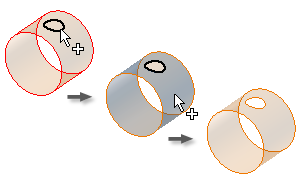When surfaces are exported from CAD systems that have a greater tolerance than Inventor, they cannot be consumed by Inventor because of their poor quality. These surfaces require manual repair before being used in part modeling. You can trim surfaces repair and construction environments using selected edges or wires which form a closed trim boundary. You can also extract surface loops to replace a surface with one that is not trimmed by the original edges. Use this technique to use edges from adjacent surfaces to trim the untrimmed surface.
Trimming Surfaces with a Closed Boundary

Use Boundary Trim to clean and repair trimming curves that result from poorly translated surfaces. Boundary Trim rebuilds a surface to leverage wires or edges on adjacent surfaces. The edges and wires must create a closed loop for use as a new trimming curve, and they must be within the bounding area of the surface. The following is a typical workflow in which Boundary Trim repairs a translated surface:
- Extract one or more loops from a surface (using Extract Loop), leaving an untrimmed surface.
- Use the Boundary Trim command to rebuild the untrimmed surface.
Extracting Loops to Untrim a Surface

When you extract one or more loops, you untrim a surface, replacing it with one that is not trimmed by the original edges. Once extracted, the loops become wires, which, along with other wires or edges, can be used to form a new trimming curve
When the original wires have formed poor quality trimming curves, you can use the edges of other surfaces to form a trim boundary. You can also use a combination of the original wires and the edges of other surfaces. The Extract Loop command includes a Delete Wires option, so you can delete the existing edges of the surface rather than change them to wires.